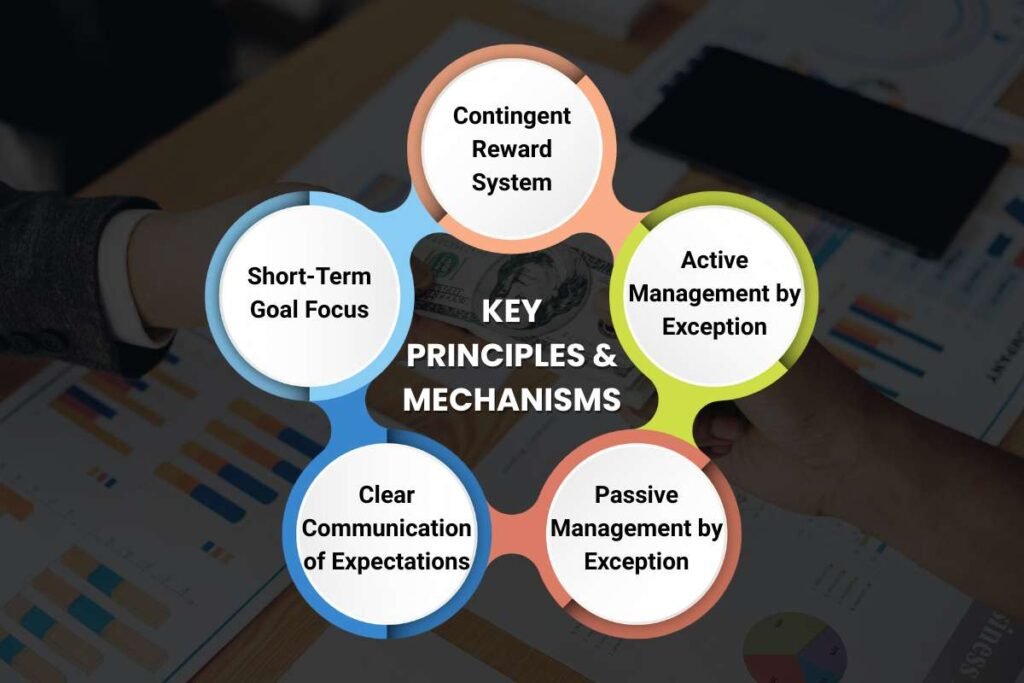Many leaders use a structured, goal-oriented approach to manage their teams. They set clear expectations, reward good performance, and apply fair consequences when targets aren’t met. This method forms the backbone of many successful organizations today.
Transactional leadership focuses on the exchange between managers and employees. Leaders provide structure and clarity, while employees deliver consistent results. This style works best in industries that rely on precision, safety protocols, and uniform performance standards, such as manufacturing, logistics, and healthcare.
While some critics argue it can limit creativity, this leadership style has evolved to match changing workforce dynamics, remote work trends, and digital communication tools. Transactional leadership can create order, boost accountability, and drive predictable outcomes when applied thoughtfully. This article will classify its key traits, modern applications, advantages, drawbacks, and relevance in workplaces, helping you decide if this management approach suits your organization.
What is Transactional Leadership?
The management approach focuses on rewards and punishments to drive performance. Leaders prioritize structure and routine, emphasizing smooth daily operations. They depend more on authority than personal charisma and often pay little attention to employees’ emotions. Here, leaders define specific goals, like meeting a weekly sales target or completing a project by a deadline, and offer rewards when those goals are met. If targets slip, they address the shortfall immediately, often with corrective feedback or adjustments to workload.
This style assumes people will perform well when they understand what’s expected and see a direct link between their effort and an outcome they value. It focuses on structure and accountability, making it a natural fit for roles where safety, accuracy, or strict compliance matter. Think of manufacturing teams following safety protocols or customer-service agents meeting call-handling targets.
While this leadership style is sometimes painted as rigid, it has its strengths. Offering tangible incentives and clear rules keeps teams aligned and helps managers spot issues before they grow.
Key Principles & Mechanisms

Transactional leadership operates through five fundamental principles that shape how managers interact with their teams and drive organizational results:
1. Contingent Reward System
This principle forms the foundation of transactional leadership by creating direct links between performance and outcomes. Managers establish specific targets such as monthly sales figures or production quotas, then provide predetermined rewards when employees meet these benchmarks. These rewards can range from financial bonuses and promotions to public recognition during team meetings or additional paid time off.
The contingent reward approach works because it removes ambiguity from the work relationship. Employees understand precisely what they need to accomplish to earn specific benefits. A sales representative knows that closing 15 deals this month earns a bonus, while a factory worker understands that maintaining zero safety violations results in preferred shift assignments.
2. Active Management by Exception
Leaders who use this principle closely monitor work processes and intervene early when they identify potential problems or deviations from established standards. Rather than waiting for issues to escalate, these managers track progress through regular check-ins, performance dashboards, or quality control inspections.
Active management means leaders stay involved throughout project execution. They review reports daily, attend status meetings, and maintain open lines of communication with team members. When performance starts to slip or processes drift from approved methods, they provide immediate feedback and corrective guidance. This approach prevents minor issues from becoming major problems that could derail entire projects.
3. Passive Management by Exception
This principle represents a more hands-off approach where leaders intervene only after problems or performance standards have been clearly missed. Managers using passive management give employees more autonomy in their daily work but maintain strict consequences for failures.
While passive management provides more workplace freedom, it still contains clear accountability measures. Employees know that missing deadlines, failing quality checks, or violating company policies will result in corrective actions such as additional training, closer supervision, or formal disciplinary procedures. This approach works best with experienced team members who understand expectations and can work independently.
4. Clear Communication of Expectations
Effective transactional leaders eliminate guesswork by spelling out precise goals, success metrics, and timelines for every assignment. They document job requirements, provide detailed task instructions, and establish measurable performance standards without room for misinterpretation.
This communication extends beyond initial goal-setting, including regular progress updates and feedback sessions. Leaders explain what needs to be done, how success will be measured, and what specific outcomes will trigger rewards or consequences. They hold team meetings to review expectations, send summaries of key points, and create reference documents that employees can consult when questions arise.
5. Short-Term Goal Focus
Transactional leadership emphasizes immediate, measurable results over long-term strategic planning or employee development. Leaders set targets that can be achieved and evaluated within weeks or months rather than years. This might include daily production numbers, weekly customer service ratings, or monthly revenue targets.
The short-term focus allows for quick adjustments and rapid problem-solving. Transactional leaders can quickly modify goals and redirect team efforts when market conditions change or customer demands shift. This flexibility helps organizations respond to immediate challenges while maintaining consistent performance standards across all departments.
Transactional Leadership in 2025: Is It Outdated or More Relevant Than Ever?
While some view this leadership style as old-fashioned, it has evolved with modern technology. Real-time performance tracking and instant feedback systems make reward-based management more effective. Industries requiring strict compliance, such as healthcare, finance, and manufacturing, still rely on clear benchmarks and swift consequences for safety and quality. However, successful leaders now blend transactional methods with employee-focused approaches to balance immediate results with long-term innovation.
Advantages and Disadvantages of Transactional Leadership
| Advantages | Disadvantages |
| – Clear expectations and goals that reduce confusion | – Can lead to disengagement when employees feel unvalued beyond tasks |
| – Quick feedback and rewards maintain steady performance | – Emphasis on short-term targets may ignore long-term growth and innovation |
| – Strong compliance with regulations and safety protocols | – Overreliance on monitoring tools can erode trust among team members |
| – Fairness through structured benchmarks supports accountability and DEI efforts | – Limited focus on emotional intelligence can weaken team cohesion and morale |
| – Effective for managing AI-driven workflows with clear reward signals | – Risk of punitive culture when consequences are applied without supportive coaching |
Examples of Transactional Leadership in Action
1. Global Logistics Provider

A major delivery company set up a real-time system that tracks errors. Drivers who complete all their deliveries without mistakes earn extra days off each month. This clear reward for error-free work keeps safety and accuracy high.
2. Hospital Network
A regional health system ties small perks to patient feedback scores. Nurses who meet or exceed satisfaction targets receive gift vouchers or get first pick of shifts. This direct link between patient care and rewards helps keep service consistent and staff motivated.
3. E-Commerce Support Team
An online retailer uses a gamified platform where agents earn badges and cash bonuses for closing support tickets within set times. The instant feedback on performance and tangible rewards drive fast, reliable service.
4. Manufacturing Plant

A factory installed sensors on its assembly lines to monitor safety incidents. Teams that maintain accident-free records for defined periods receive safety bonuses and public recognition during staff meetings. This approach reinforces protocol adherence and team accountability.
5. Consulting Firm
A large consultancy firm breaks big projects into smaller milestones. Consultants earn incremental cash incentives as they meet each deadline on time. This step-by-step reward system boosts focus on short-term goals and keeps complex projects on track.
Transactional Leadership vs. Other Leadership Styles
| Style | Focus | Advantages | Best Use Cases |
| Transactional | Clear goals and a reward/consequence system | Predictable outcomes, strong accountability | Compliance-driven environments, crisis response |
| Transformational | Vision, inspiration, personal growth | High engagement fosters innovation | Organizational change, long-term strategy |
| Servant | Employee needs and development | Trust building, strong team morale | People-centric cultures, nonprofit sectors |
| Democratic | Team input and consensus | Better buy-in, diverse ideas | Collaborative projects, creative industries |
| Laissez-Faire | Autonomy and minimal oversight | Encourages independence, rapid experimentation | Expert teams, R&D settings |
Skills Required for Effective Transactional Leaders

- Strong communication to set clear goals and expectations
- Consistent fairness in applying rewards and consequences
- Attention to detail for monitoring performance metrics
- Decisiveness to act quickly when standards slip
- Basic data literacy for using performance-tracking tools
- Emotional awareness to balance firmness with support
- Time management for timely feedback and reviews
- Adaptability to adjust targets as conditions change
Conclusion
Transactional leadership remains a practical way to drive precise results and uphold standards. Leaders can keep teams focused and accountable by combining direct exchanges of effort and reward with modern tools and thoughtful support. When used alongside more inspiring approaches, this style delivers quick wins while laying a foundation for steady, reliable performance.
FAQs
Q1: Can transactional leadership work remotely?
A: Yes. Real-time tracking tools and virtual recognition make it easy to reward achievements from anywhere.
Q2: How often should feedback be given?
A: Ideally, feedback comes immediately after key milestones or when issues emerge.
Q3: Is transactional leadership too rigid?
A: It can feel strict, but adding supportive coaching and occasional team input eases rigidity.
Q4: What industries benefit most?
A: Fields needing safety, compliance, or precise output—such as healthcare, manufacturing, and finance- gain the most.

.jpg)










